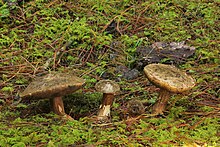| Porphyrellus porphyrosporus | |
|---|---|

| |
| Scientific classification | |
| Domain: | Eukaryota |
| Kingdom: | Fungi |
| Division: | Basidiomycota |
| Class: | Agaricomycetes |
| Order: | Boletales |
| Family: | Boletaceae |
| Genus: | Porphyrellus |
| Species: | P. porphyrosporus |
| Binomial name | |
| Porphyrellus porphyrosporus (Fr. & Hök) E.-J.Gilbert (1931) | |
| Synonyms | |
| Porphyrellus porphyrosporus | |
|---|---|
| Pores on hymenium | |
| Cap is convex | |
| Hymenium is adnate | |
| Stipe is bare | |
| Spore print is purple to brown | |
| Ecology is mycorrhizal | |
| Edibility is inedible | |
Porphyrellus porphyrosporus, commonly known as the dusky bolete, is a rare fungus belonging to the family Boletaceae. With its purple-brown cap and stem, P. porphyrosporus is not easy to spot, despite its large size. This summer and autumn species occurs under pines, but can also be found beneath deciduous trees. It is a large (both cap diameter and stem length up to 15 cm) brown bolete. Its most distinctive features are the purple-brown spore print and the blue-green colour of the flesh at the top of the stem and above the hymenium.
This is a widespread species of Europe, especially in the north, but is nowhere particularly common. The fruit bodies appear from late summer to autumn, often in small groups, associated with broad-leaved trees such as beech and oak.
Description
This mushroom has a dark brown cap, usually with a paler margin. Initially convex, caps expand and sometimes become irregularly lobed. It is 6 to 15 cm (2+3⁄8 to 5+7⁄8 in) in diameter when fully expanded, and the caps have soft buff flesh with a vinaceous tinge. The tubes are similar in colour to the cap, and when cut or bruised, turn blue-green. The stem is 5 to 16 cm (2 to 6+1⁄4 in) tall and 1 to 3 cm (3⁄8 to 1+1⁄8 in) in diameter, equal or clavate, tobacco brown and slightly velvety to the touch when young, becoming smooth as the fruit body matures. The mushroom has an unpleasant sour taste and odour. One guide lists the species as edible, while another considers it "probably edible".
Tylopilus indecisus is a similar species.

References
- "Porphyrellus porphyrosporus (Fr. & Hök) E.-J. Gilbert 1931". MycoBank. International Mycological Association. Archived from the original on 2011-09-30. Retrieved 2011-10-01.
- ^ Trudell, Steve; Ammirati, Joe (2009). Mushrooms of the Pacific Northwest. Timber Press Field Guides. Portland, OR: Timber Press. p. 228. ISBN 978-0-88192-935-5. Archived from the original on 2024-04-30. Retrieved 2024-04-30.
- ^ Davis, R. Michael; Sommer, Robert; Menge, John A. (2012). Field Guide to Mushrooms of Western North America. Berkeley: University of California Press. p. 315. ISBN 978-0-520-95360-4. OCLC 797915861. Archived from the original on 2022-06-03. Retrieved 2024-04-30.
- Phillips, Roger (2010). Mushrooms and Other Fungi of North America. Buffalo, NY: Firefly Books. p. 281. ISBN 978-1-55407-651-2.
- Wood M, Stevens F. "Tylopilus porphyrosporus". California Fungi. Archived from the original on 2017-12-09. Retrieved 2011-02-23.
Further reading
- Mushrooms and Toadstools of Britain and Europe, Stefan Buczacki (HarperCollins, 1992)
| Taxon identifiers | |
|---|---|
| Porphyrellus porphyrosporus | |
| Boletus porphyrosporus | |